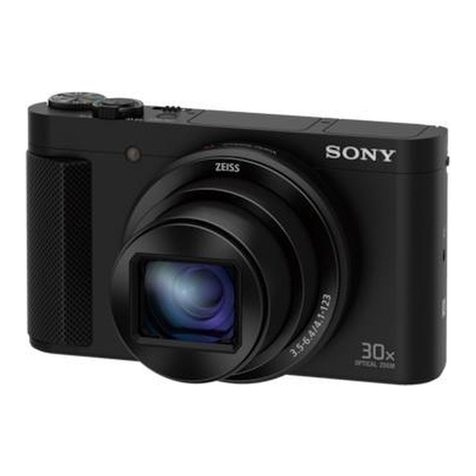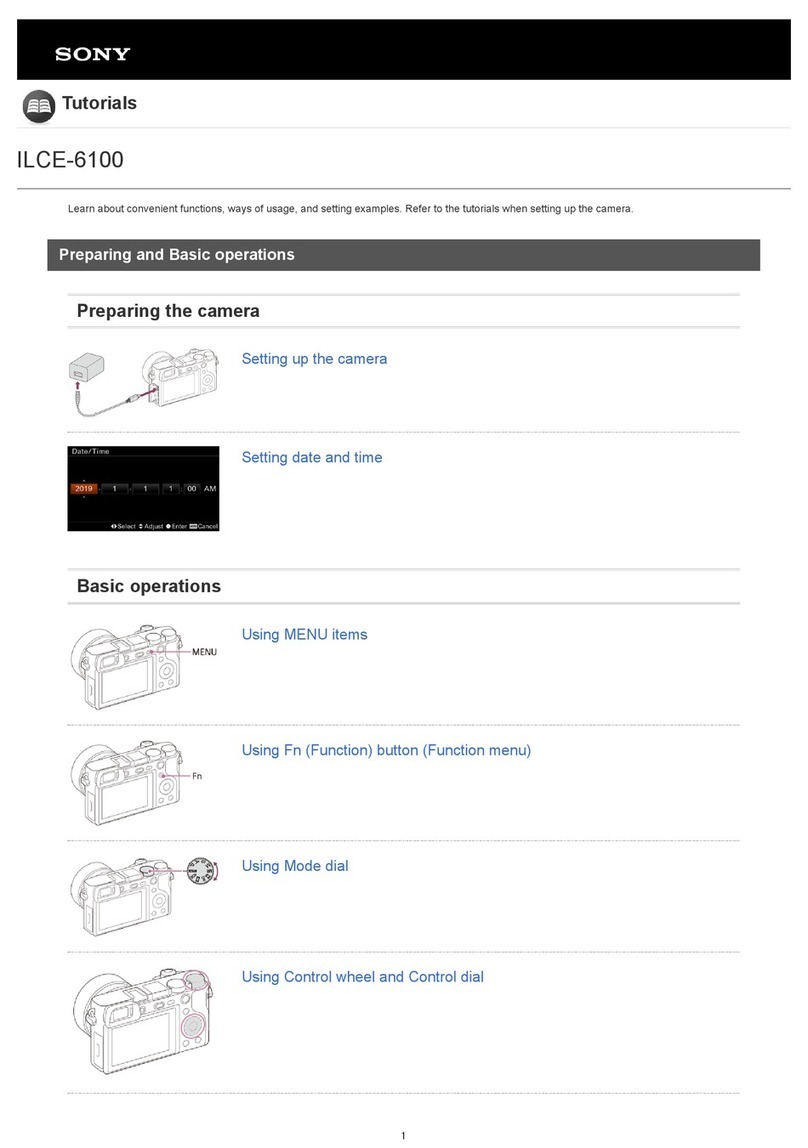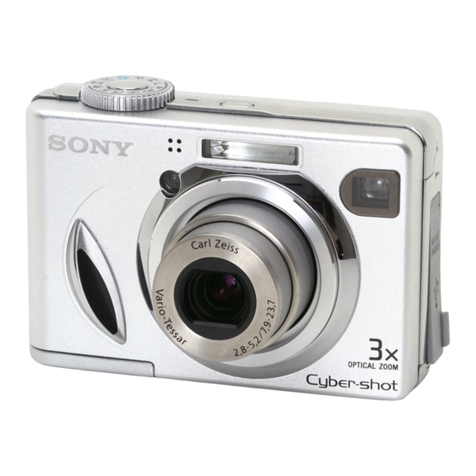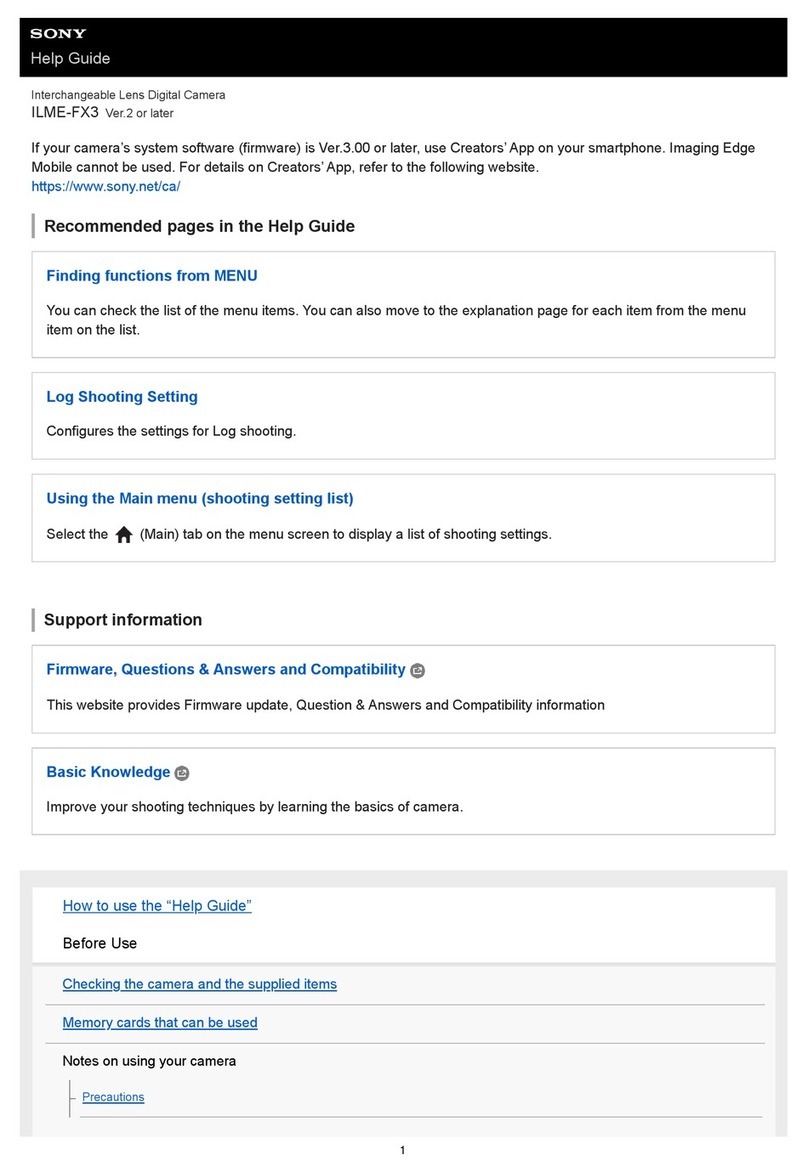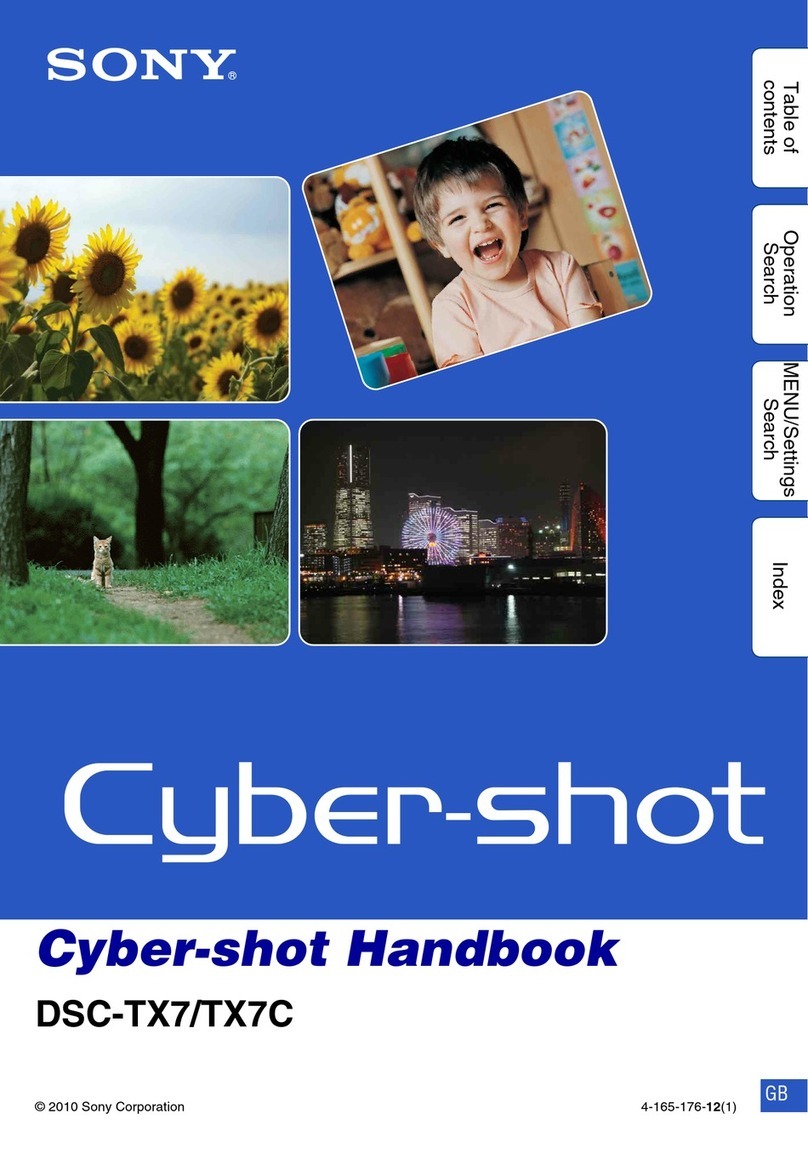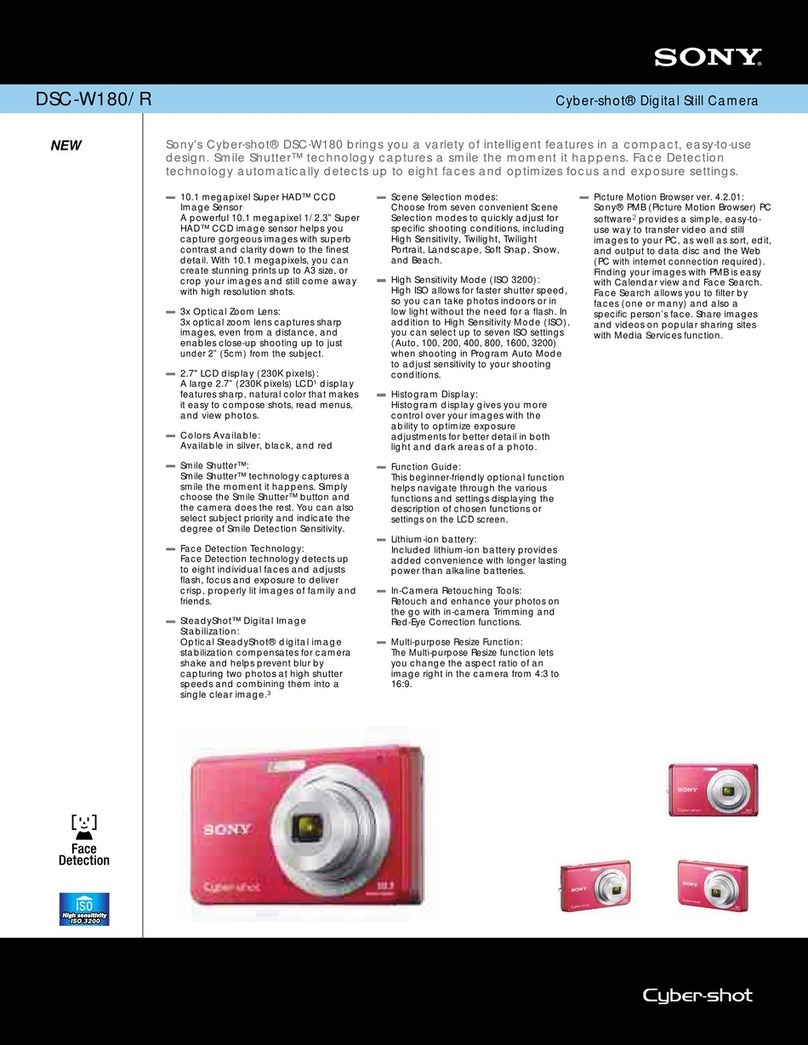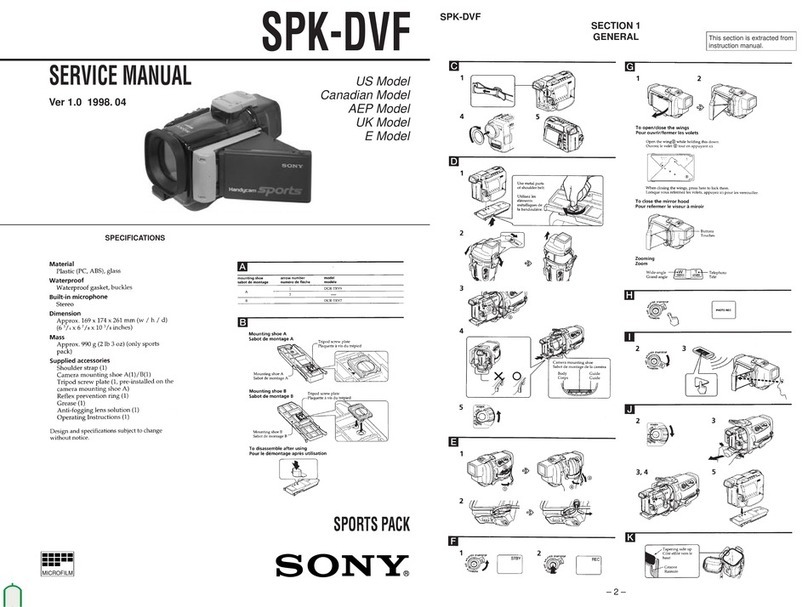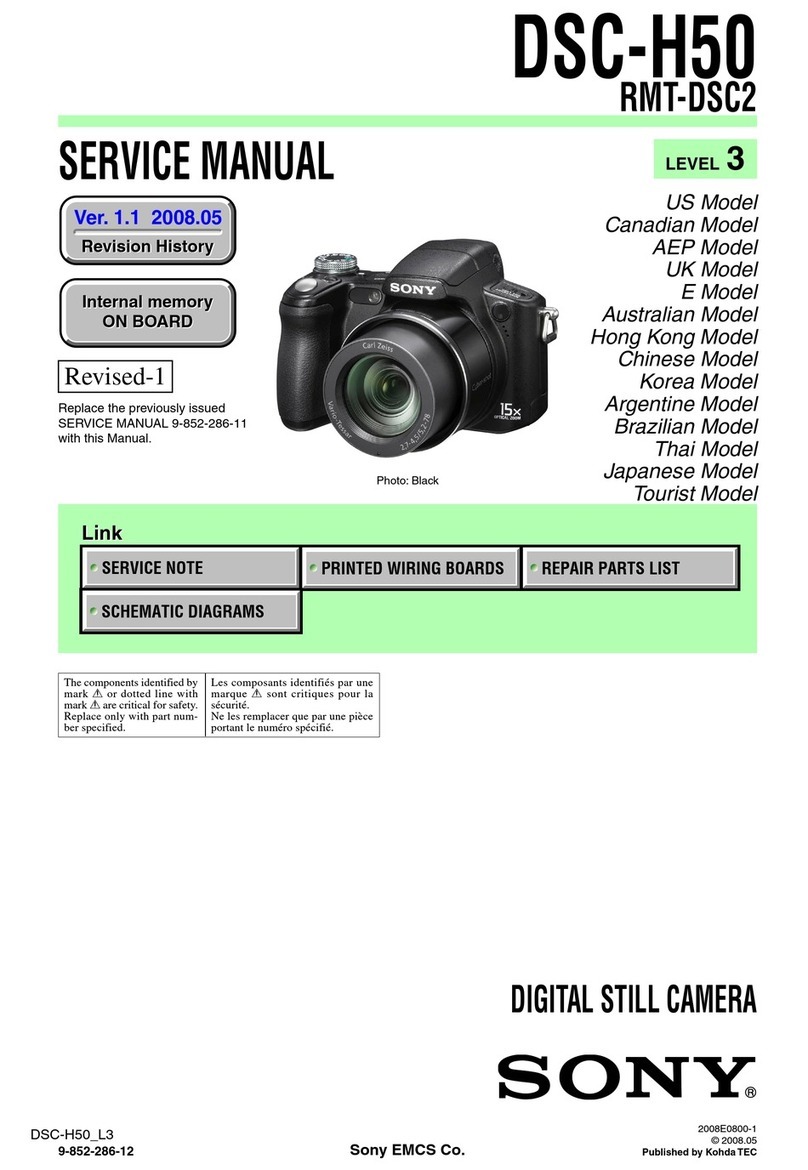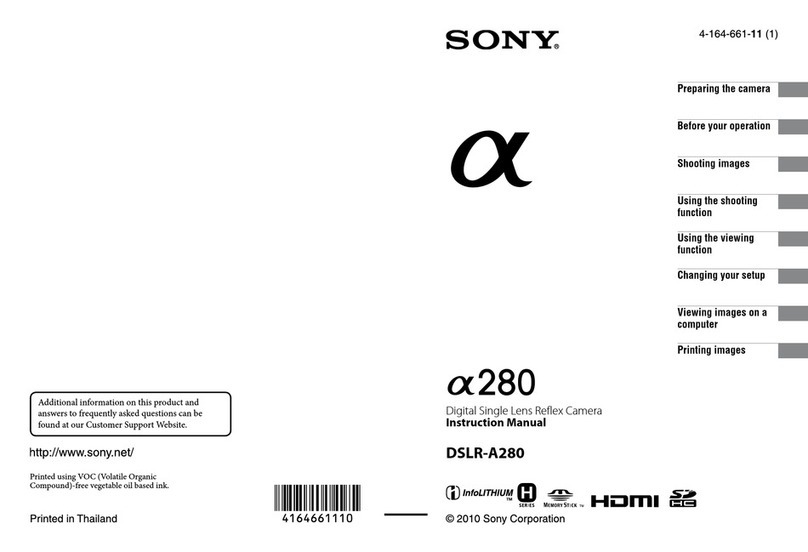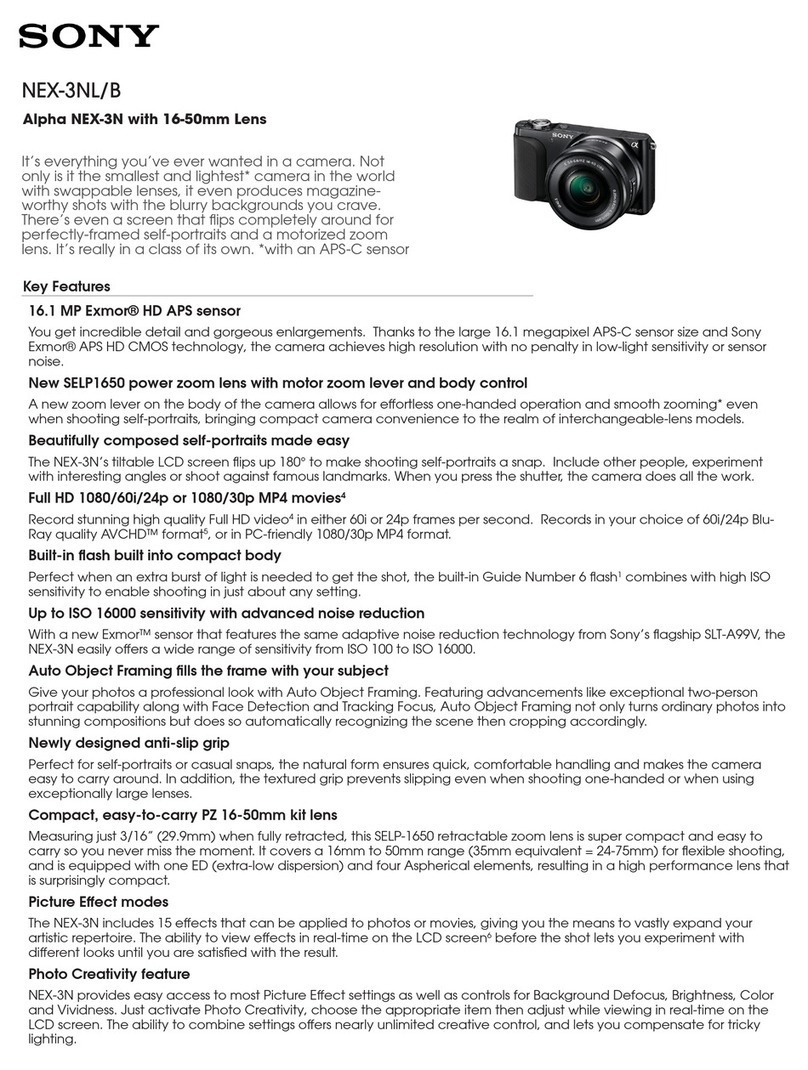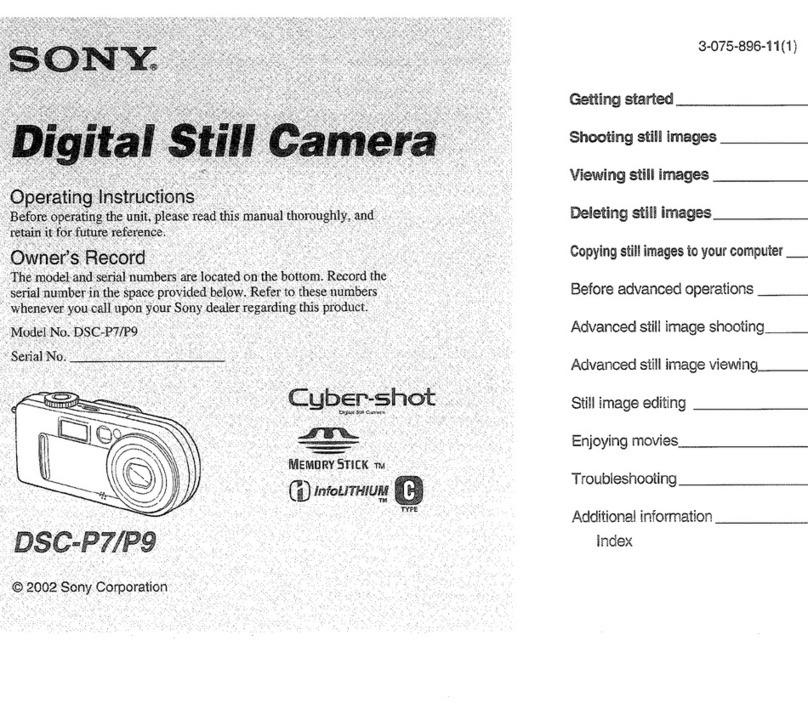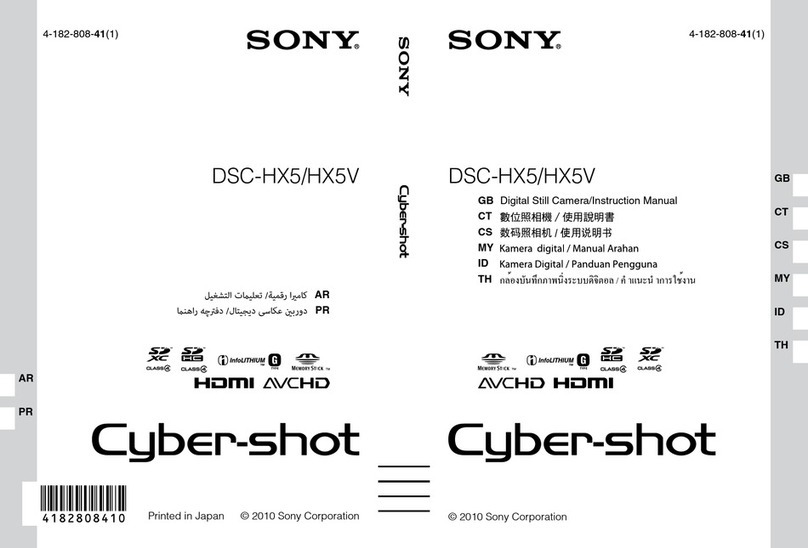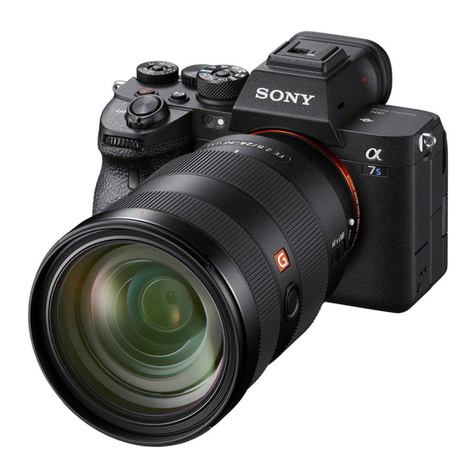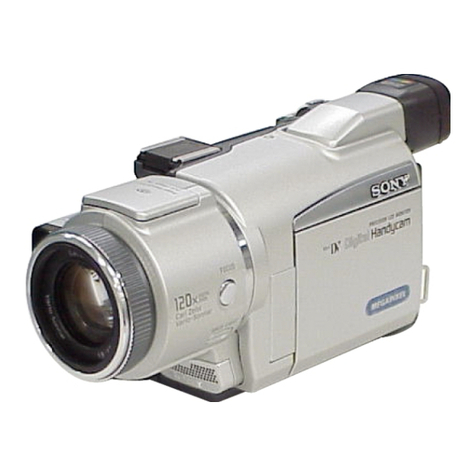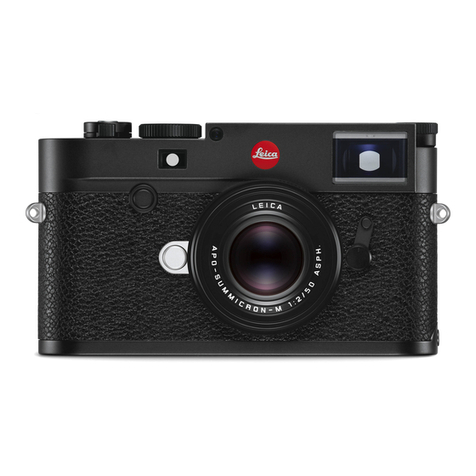
Preparations
Before Installation
1Press the locking hook inward and meanwhile turn the dome casing
anticlockwise, and remove the dome casing from the camera unit.
2Press inward and hold the dent on both sides of the slit cover as shown in the
illustration to remove the black slit cover.
3Remove the base bracket.
Slide the base bracket clockwise after pressing the buckle on the base bracket
inwards to separate it from the hook.
4After deciding the direction in which the camera will shoot, make the
required hole (ø17 mm 11/16 inch) using the supplied base bracket. Then
decide the position of the two mounting holes to install the camera unit.
Note
After deciding the direction in which the camera will shoot, turn the
“
” mark to face the opposite direction to that of shooting. When
installing the camera on a wall (not on a ceiling), face the“
” mark
upward.
Mounting screws
The base bracket is provided with two 5 mm × 8 mm (7/32 inch × 11/32 inch)
mounting holes. Install the base bracket on the ceiling/wall with two screws
(center distance 57 mm(2 1/4inch)). Mounting distance: 54 mm ~ 60 mm
(2 1/4inch ~ 2 3/8inch).
The required mounting screws differ depending on the installation location and
its material. (Mounting screws are not supplied.)
Steel wall or ceiling: Use M4 bolts and nuts.
Wooden wall or ceiling: Use M4 tapping screws. The panel thickness must be
15 mm (5/8inch) or more.
Concrete wall: Use anchors, bolts and plugs suitable for concrete walls.
Junction box: Use screws to match the holes on the junction box.
WARNING
The required mounting screws differ depending on the installation location and
its material. If you do not secure the camera with the appropriate mounting
screws, the camera may fall off.
Installation
WARNING
If you attach the camera in the height such as the wall or the ceiling, etc.,
entrust the installation to an experienced contractor or installer.
If you install the camera on the ceiling, ensure that the ceiling is strong
enough to withstand the weight (15 Kg) of the camera and then install the
camera securely. If the ceiling is not strong enough, the camera may fall and
cause serious injury.
When installing the camera on a ceiling or a high location, be sure to secure a
wire rope (not supplied) to the camera for safety.
If you attach the camera to the ceiling, check periodically, at least once a year,
to ensure that the connection has not loosened. If conditions warrant, make
this periodic check more frequently.
Attaching the fall-prevention rope
When you install the camera on a ceiling or a high location, be sure to attach a
wire rope (not supplied) to prevent the camera from falling. Thread the wire rope
through the hole on the rear of the camera, and then fix it to the junction box on
the ceiling or wall with a screw (not supplied), as in the illustration.
For details about the wire rope, please consult the store of purchase or an
authorized Sony dealer.
Note
Take care to avoid any short-circuits with the wire rope when you attach it.
Installing the Camera
1Attach the base bracket to the ceiling or wall with two mounting screws (not
supplied).
2As shown in the illustration, align the TOP position of the camera unit with
the “
” position of the base bracket and set in place. Turn the main unit
clockwise until it clicks.
Adjusting the Camera Direction and Coverage
Turn the lens in the desired direction.
You can adjust the lens position horizontally ( ), vertically ( ) or by rotation
( ).
Note
When adjusting the lens position, be sure that the“
” mark on the Pan
adjuster (see figure ) is toward the ceiling. If the camera is installed with the
“
” mark toward the floor, the image will appear upside down.
When adjusting the lens horizontally ( ), vertically ( ) or rotation ( ), if no
further adjustment becomes apparent, do not forcedly adjust the lens.
Attaching the Dome Casing
1Align the notch on the slit cover with the protrusion, which is in the same
direction as that of the lens-tilt, on the vertical adjuster (see figure 2), and
press the slit cover downward until it clicks.
2As shown in the illustration, align the projection part with the slit of the base
bracket, and turn the dome casing in the direction of the arrow until it clicks.
Ensure the camera unit is set tightly.
Typical CCD phenomenon
The following phenomena that may appear in images are specific to CCD
(Charge Coupled Device) image sensors. They do not indicate malfunctions.
White flecks
Although the CCD image sensors are produced with high-precision technologies,
fine white flecks may be generated on the screen in rare cases, caused by cosmic
rays, etc.
This is related to the principle of CCD image sensors and is not a malfunction.
The white flecks especially tend to be seen in the following cases:
when operating at a high environmental temperature
when you have raised the gain (sensitivity)
when using the slow shutter
Vertical smear
When an extremely bright object, such as a strong spotlight or flashlight, is
being shot, vertical tails may be produced on the screen, or the image may
be distorted.
Monitor screen Vertical tails shown on the image
Bright object (e.g., strong spotlight,
strong reflected light, flashlight, the sun)
Aliasing
When fine patterns, stripes, or lines are shot, they may appear jagged or
flicker.
English
准备
安装前
1向内按锁定钩,同时逆时针转动圆顶罩,然后从摄像机上取下圆顶罩。
2向内侧按住开口罩上如图所示的两侧的凹痕,取下黑色开口罩。
3拆卸底座
将底座上的卡扣向内按,使卡扣脱离本体上的卡钩后,顺时针滑开底座。
4确定摄像机拍摄方向后,用底座制作所需的电缆连接孔(ø17 mm)。然
后确定两个安装孔的位置以安装摄像机。
注意
决定摄像机的拍摄方向后,请将“
”标记转向拍摄方向的反方向。将
摄像机安装在墙壁(非天花板)上时,请让“
”标记朝向上方。
安装螺丝
底座带有两个 5 mm ×8 mm 的安装长孔。使用螺丝通过两个中心距离
57 mm 的安装长孔将底座安装在天花板或墙上。适用安装距离为
54 mm~60 mm。
根据安装位置及其材料的不同,所需的安装螺丝也有所不同。(安装螺丝未
附带。)
钢制墙壁或天花板:使用 M4 螺栓和螺母。
木制墙壁或天花板:使用 M4 自攻螺丝。面板厚度必须为 15 mm 或以上。
水泥墙壁:使用适用于水泥墙壁的锚、螺栓和楔子。
接线盒:使用与接线盒上的孔相匹配的螺丝。
警告
根据安装位置及其材料的不同,所需的安装螺钉也有所不同。如果您没有使
用合适的安装螺钉将摄像机安装牢靠,摄像机有可能坠落。
安装
警告
如果要将摄像机安装在墙壁或天花板等高处,请将安装工作委托给有经验
的承包商或安装人员。
如果要将摄像机安装在天花板上,必须确保天花板有足够的强度承受摄像
机的重量(15 Kg),然后再牢固安装摄像机。如果天花板强度不够,则摄
像机可能掉落并造成严重的人员受伤。
将摄像机安装到天花板或较高的位置时,出于安全,必须将防坠绳(未附
带)固定在摄像机上。
如果将摄像机安装在天花板上,请定期检查,每年至少一次,以确保连接
没有松动。如果条件允许,请更频繁定期检查。
安装防坠绳
将摄像机安装在天花板或较高位置时,必须安装防坠绳(未附带),以防止
摄像机掉落。如图所示,将防坠绳穿过摄像机背面的孔,然后用螺丝(未附
带)固定于天花板或墙上的接线盒。有关防坠绳的详情,请向购买商店或授
权Sony 经销商咨询。
注意
连接时请小心,以免与防坠绳发生短路。
安装摄像机
1使用两颗安装螺丝(未附带)将底座安装到天花板或墙上。
2如图所示,将摄像机本体的 TOP 位置对准底座的“
”位置并放入,顺
时针旋转摄像机本体,听到“啪”的一声之后安装到位。
调节摄像机的方向和范围
按所需方向转动镜头。
可通过镜头的水平( )、垂直( )或旋转( )来调节镜头位置,确定
摄像机的方向和范围。
注意
在调节镜头位置时,务必使水平调节器 (参见图 ) 上的“
”标记朝向
天花板。如果摄像机在“
”标记朝向地板的状态下被安装,则显示的
图像会颠倒。
当通过水平( )、垂直( )或旋转( )调节镜头时,遇到止动装置
时,请勿强制调整。
安装圆顶罩
1将开口罩的缺口与垂直调节器上与镜头倾斜方向同侧的凸起(参见图
2)位置对齐,将开口罩按下,直至听到喀嗒声。
2如图所示,将圆顶罩上的突起部与底座的缺口部对齐,并且沿箭头方向转
动圆顶罩,直至听到喀嗒声。然后确保摄像机安装牢固。
典型 CCD 现象
图像中可能出现的以下现象是 CCD(电荷耦合器件)图像传感器所特有的。
这些现象不是故障。
白斑
虽然 CCD 图像传感器是采用高精度技术生产的,但由于宇宙射线等的影响,
其屏幕上可能会出现细小的白斑(极少数情况)。
这与 CCD 图像传感器的原理有关,出现的白斑并不是故障。
在以下情况中,比较容易出现白斑:
在高温环境下进行操作时
提高倍率(灵敏度)时
当使用慢快门时
垂直拖影
拍摄亮度极高的物体(如强聚光灯或闪光灯)时,屏幕上可能出现垂直尾
线,图像也可能出现扭曲。
图像上的垂直拖尾显示
监视器屏幕
高亮物体(如强聚光灯、强
反射光、闪光灯、阳光)
图形失真
拍摄微小的图案、条纹或线条时,它们可能呈锯齿状或出现闪烁现象。
中文
Long hole/
长螺丝孔
Side/边侧
Ø85.2(3 3/8)
63.5(2 1/2)57(2 1/4)
4
3
Notch/
缺口
2
Dome slit/
开口罩
Protrusion/
凸起
Dent (two sides)/
凹痕(2侧)
Dome casing/圆顶罩
1
1
2
Wire rope (not
supplied)/防坠绳
(未附带)
Screw (not supplied)/
螺丝(未附带)
Ceiling/天花板
Base bracket/
底座
Buckle/卡扣
Tilt adjuster/
垂直调节器
Pan adjuster/
水平调节器
Notch/缺口
Protrusion/
突起部
1
Dome slit/
开口罩
Dome casing/
圆顶罩
2
Unit : mm (inches)/单位:mm
Specifications
Image device Interline transfer 1/3 type Super HAD CCD II™
(SSC-N12)
Interline transfer 1/3 type EXview HAD CCD II™
(SSC-N14)
Effective picture elements 752 (H) × 582 (V) PAL (SSC-N12)
976 (H) × 582 (V) PAL (SSC-N14)
Focal length 6 mm
Maximum relative aperture F1.8
View angle Horizontal: 46°
Vertical: 35°
Minimum object distance 0.4 m
Signal system PAL color system
Synchronization system Internal (DC 12 V)
Horizontal resolution 540 TV lines (SSC-N12)
650 TV lines (SSC-N14)
Minimum illumination 0.30 lx (AGC ON, F1.8, 50 IRE, Color)
0.18 lx (AGC ON, F1.8, 30 IRE, Color)
0.20 lx (AGC ON, F1.8, 50 IRE, B/W)
0.07 lx (AGC ON, F1.8, 30 IRE, B/W)
Video output 1.0 Vp-p, 75 , negative sync , BNC cabel
Video S/N ratio More than 55 dB (AGC OFF)
White balance ATW
AGC ON/OFF switchable
iBLC ON/OFF switchable
ATR-Lite ON/OFF switchable
Monitor out BNC
Power supply DC 12 V ±10%
Power consumption 0.9 W
Operating temperature –10°C to +50°C (14°F to 122°F)
Storage temperature –40°C to +60°C (–40°F to +140°F)
Operating humidity 20% to 80%
Storage humidity 20% to 95%
Dimensions (diameter/height) ø85.2 mm × 63.5 mm (ø3 3/ inches × 2 1/ inches)
Mass Approx. 140 g (4.9 oz)
Supplied accessories Operating instructions (this document) (1)
Option Wire rope (available separately)
Design and specifications are subject to change without notice.
Note
Always verify that the unit is operating properly before use. SONY WILL
NOT BE LIABLE FOR DAMAGES OF ANY KIND INCLUDING, BUT NOT LIMITED
TO, COMPENSATION OR REIMBURSEMENT ON ACCOUNT OF THE LOSS OF
PRESENT OR PROSPECTIVE PROFITS DUE TO FAILURE OF THIS UNIT, EITHER
DURING THE WARRANTY PERIOD OR AFTER EXPIRATION OF THE WARRANTY,
OR FOR ANY OTHER REASON WHATSOEVER.
Recommendation of Periodic Inspections
In case using this device over an extended period of time, please have it
inspected periodically for safe use.
It may appear awless, but the components may have deteriorated over
time, which may cause a malfunction or accident.
For details, please consult the store of purchase or an authorized Sony
dealer.
规格
成像器件 1/3 英寸型行间转移方式 Super HAD CCD II™
(SSC-N12)
1/3 英寸型行间转移方式 EXview HAD CCD II™
(SSC-N14)
有效像素 752(水平)× 582(垂直)PAL (SSC-N12)
976(水平)× 582(垂直)PAL (SSC-N14)
焦距长度 6 mm
最大相对光圈 F1.8
可视角度 水平:46°
垂直:35°
最小对象距离 0.4 m
信号系统 PAL 彩色系统
同步系统 内置(12 V 直流电源)
水平分辨率 540 电视线 (SSC-N12)
650 电视线 (SSC-N14)
最低照度 0.30 lx (AGC ON, F1.8, 50 IRE,彩色)
0.18 lx (AGC ON, F1.8, 30 IRE,彩色)
0.20 lx (AGC ON, F1.8, 50 IRE, 黑/白)
0.07 lx (AGC ON, F1.8, 30 IRE, 黑/白)
视频输出 1.0 Vp-p,75 Ω,负同步 BNC 电缆
视频信噪比 55 dB 以上(AGC OFF)
白平衡 ATW
AGC ON/OFF 可切换
iBLC ON/OFF 可切换
ATR-Lite ON/OFF 可切换
监视器输出 BNC
电源 12 V 直流电源 ±10%
功率消耗 0.9 W
操作温度 –10°C 至+50°C
存放温度 –40°C 至+60°C
操作湿度 20% 至80%
存放湿度 20% 至95%
尺寸(直径/高度) ø85.2 mm ×63.5 mm
重量 约140 g
附件 使用说明书(本文档)(1)
选购配件 防坠绳(可另行购买)
设计及规格若有更改恕不另行通知。
注意
在使用前请始终确认本机运行正常。无论保修期内外或基于任何理由,
SONY 对任何损坏概不负责。由于本机故障造成的现有损失或预期利润
损失,不作(包括但不限于)退货或赔偿。
定期检查建议
长时间使用本设备时,请定期检查本设备以便安全使用。
虽然设备似乎没有问题,但是长时间使用时其组件质量可能已经下降,从
而可能引起故障或事故。
有关详细说明,请咨询购买商店或授权的 Sony 经销商。
产品中有毒有害物质或元素的名称及含量
使用环境条件:参考使用手册中的操作条件
部件名
称
有毒有害物质或元素
铅
(Pb)
汞
(Hg)
镉
(Cd)
六价铬
(Cr (VI))
多溴联苯
(PBB)
多溴二苯醚
(PBDE)
实装基
板× ○ ○ ○ ○ ○
外壳 × ○ ○ ○ ○ ○
光学组
件× ○ ○ ○ ○ ○
附属品 × ○ ○ ○ ○ ○
○:表示该有毒有害物质在该部件所有均质材料中的含量均在
SJ/T11363-2006 标准规定的限量要求以下。
×:表示该有毒有害物质至少在该部件的某一均质材料中的含量超出
SJ/T11363-2006 标准规定的限量要求。
出版日期:2011 年3 月


